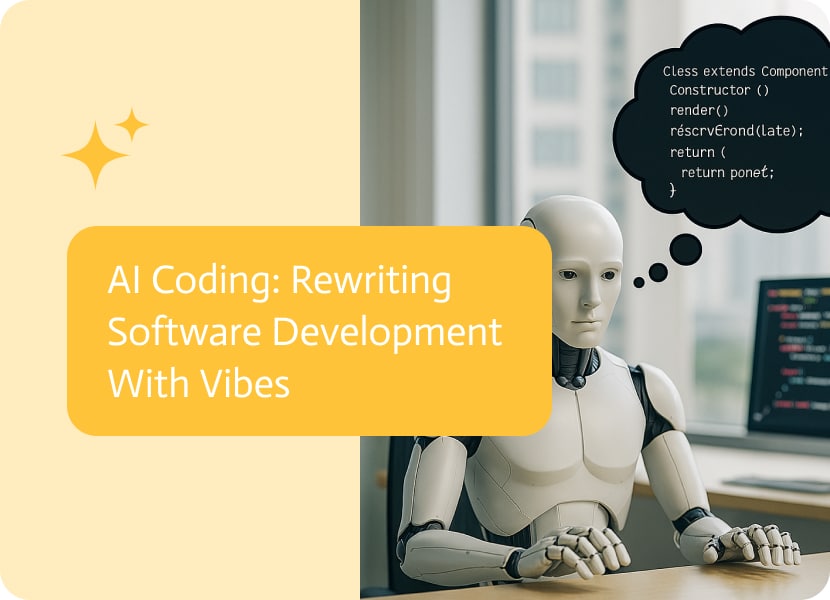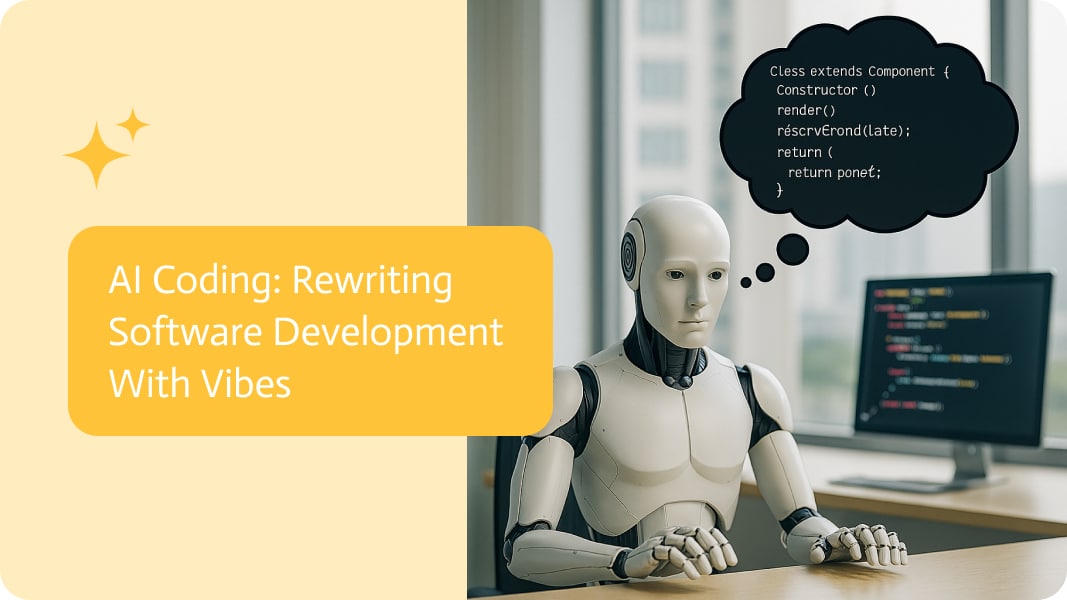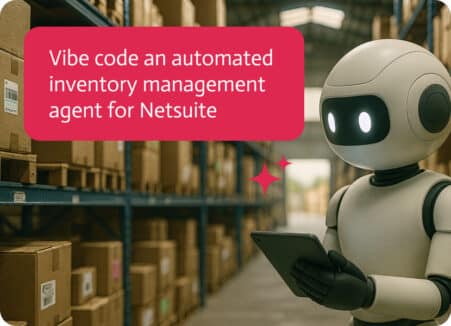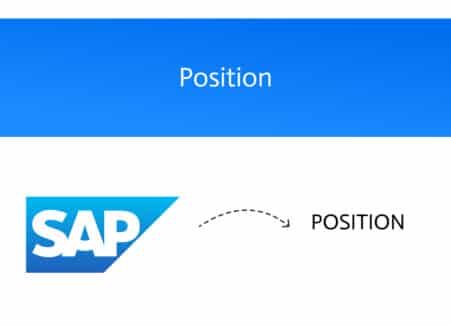

AI Coding: Rewriting Software Development
AI coding is all about using artificial intelligence, think big language models, code-creating tools, and machine learning, to make building software faster and easier. Recently, the term vibe coding has taken over the web, which is essentially another name for AI coding.
From Confusing Syntax to Smart Code: How AI Is Changing Coding
For ages, coding meant wading through manuals, memorizing commands, and fighting weird error messages. It took years to get good at it. Now, things are changing. AI is starting to code with us and sometimes even does it for us.
Artificial intelligence, like GPT-4, can do more than just answer questions. It can now write programs, rework old code, tune up searches, and fix tricky problems. What used to need serious skills can now start with a simple request.
What Is AI Coding?
At its most basic, AI coding means using smart software models, especially huge language models trained on billions of code lines, to help or even take over bits of building apps. These systems read code not just by its grammar but by what it is actually meant to do. They get the purpose, understand the task, and know how programmers usually write similar pieces in real projects.
By learning from places like GitHub, manuals, Stack Overflow answers, and everyday chats with users, the models pick up patterns, guess next moves, and spit out clean code in many languages, whether Python, TypeScript, Rust, or Ruby.
That said, the tech goes way beyond basic autocomplete. Today’s AI tools can:
- Take a plain-language request and build a whole app.
- Spot bugs and suggest faster, leaner code.
- Clean up messy, old code and break it into tidy parts.
- Explain tricky functions as a tutor would to a student.
Put simply, AI is not pushing developers out of jobs; it is making them faster and smarter.
How AI Code Generation Actually Works
At the heart of AI code generation are transformer models that rely on attention mechanisms. Systems like OpenAI’s GPT-4 and Anthropic’s Claude were trained on huge datasets that mix programming source with everyday written language. Because of this combined training, the models grasp both code logic and the intent behind human queries.
When you type something like, Build a REST API in Flask that handles user authentication, the model does not reply a stored example. Instead, it synthesizes an answer by spotting familiar patterns in the millions of requests it has processed before. Then it builds the solution piece by piece, adding best practices, error checks, and comments along the way.
The model tracks dependencies, names, scopes, and conditional paths just as a human would. Some newer systems even remember an entire project while running, so they see how files and modules connect over multiple small commands. That ability makes it possible to scaffold, construct full-stack apps, and debug code across functions in one go.
The Rise of Prompt-Based Programming
Prompt-based development has quickly become one of the coolest changes out there. Now, instead of grinding out every line yourself, a developer or curious learner can simply describe the desired feature in plain English and watch a working version appear.
Picture telling a smart tool, “Build me a dashboard that fetches sales data from Google Sheets and emails a weekly summary,” and then watching it write the Python code, hook up the Google API, style the report, and set the email schedule, all in seconds.
Services like Noca.ai are doing exactly that right now. They don’t stop at throwaway snippets; they churn out production-ready apps with input checks, logging, and quick deploy steps. For founders, designers, teachers, and ops folks who never coded, that’s a game-changer. Suddenly, they can build tools without learning the old-school programming ropes.
AI as your coding buddy: hints, auto-complete, and debugging
Even for folks already writing software, AI doesn’t grab your keyboard; it rides shotgun, quietly suggesting better paths as you drive. Add-ons like GitHub Copilot slide straight into editors such as VS Code and IntelliJ, guessing and recommending lines of code in real time from what they see you typing. Its still auto-complete, just way smarter and faster.
The helper does much more than speed up typing. Copilot spots common patterns, security holes, and solid design rules. Itll finish a tricky recursive loop, toss out a regex you forgot, or figure out business logic just from your variable names and comments.
When problems pop up-and they always do-AI doesn’t just point out the mistake. It walks through the logic behind the error, offers different options, and often rewrites the broken code for you. Developers can even drop a whole stack trace into ChatGPT and get clear, on-the-spot answers faster than any human teammate could manage.
Education Meets Engineering: AI as a Mentor
AI coding tools have gone beyond being handy. They are turning into real teachers. Beginner programmers can ask, “Why does this function return None?” or “What’s the difference between shallow and deep copies in Python?” and get clear, step-by-step answers, helpful analogies, and example code that match their current level.
Because AI never gets tired or frustrated, it gives instant feedback without judgment. It moves at your speed, tackles strange terms, and can even throw a quick quiz your way. That’s a big win for self-learners, boot-camp grads, and career swappers, since they now have a private tutor ready day or night.
Seasoned developers also gain from AI, whether they need a second opinion, a new angle on a problem, or tips to sharpen their design patterns and architecture. In other words, it’s the smartest rubber duck you could ever talk to while coding.
What About Performance, Security, and Quality?
Many people wonder whether code written by AI is fast, safe, and dependable. The short answer is: it depends, but the tools keep getting better every day.
Early AI coding helpers used to “hallucinate” whole functions—outwardly convincing yet deeply flawed. Modern models are much steadier. They now draw on compiler warnings, open-source patterns, and test suites that experienced teams have built in the real world. These tools will run unit tests, flag risky lines, and suggest performance tweaks matched to true runtime data.
Production-ready platforms go further. They weave in static analysis, security linting, and richer context so every line makes sense within the larger app. With memory, step-by-step reasoning, and chatty agents drafting together, the systems can stay consistent across projects that stretch months or years.
Still, every piece of AI-generated code must pass a human eye. Developers are moving from pure writing to high-level planning, but they remain, and always should be, the final gate. Humans keep judgment, ethics, and fixes for edge cases in play, making sure what ships is safe and solid.
Real-World Use Cases: It’s Not Science Fiction
None of this is talk about a distant future. Businesses of every size are putting AI co-pilots to work right now:
- Fresh startups are spinning MVPs overnight without ever bringing on a full-time coder.
- Large companies are cranking out internal tools and dashboards that used to eat months of engineering time.
- Teachers are using AIs to turn coding lessons into interactive, welcoming sessions that reach more learners.
- Artists are teaming with these models to craft games, interactive stories, and wild generative art experiments.
One of the biggest changes is how operations teams work day to day. They can now whip up custom reports, write quick data sync scripts, and set up workflow automations without ever entering the developer backlog. Because of AI, tools that once felt impossible for non-coders to make are open to anyone who can explain the problem clearly.
The Technical Future: What’s Coming Next
So, where do we go from here? The next wave of AI coding looks like small autonomous agents that can build whole apps, write their own documentation, test what they produce, ship it to live servers, and tidy up code whenever the rules change.
These agents are powered by advances in:
- Long-context memory: The ability to retain and reference past conversations and codebases across sessions.
- Chain-of-thought reasoning: Step-by-step breakdown of problems before generation.
- Tool use: The ability to call external APIs, run test suites, access file systems, and interact with live environments.
After that, we are headed toward voice-driven development. You just talk about the app you want, and the device spins it up instantly with a finished visual interface.
Then think about multi-agent teamwork. One AI can handle the front end, another manages the database, and a third writes the tests, and they all chat until the full system is ready.
It may sound far-off, but pieces of it are already here.
AI Coding With Noca
Although Noca is one of the newcomers to the space, it offers users of every skill level the ability to create websites and applications. Whether you’re a coding stalwart or someone who doesn’t know what HTML5 is, you’re provided with the tools to create anything you can dream of, and all with simple English prompting.
Noca doesn’t stop there though, its no-code platform also boasts exceptionally easy integrations. This means you’re able to connect your creations with little to no effort.
Final Thoughts: Code Is No Longer The Speedbump
The biggest hold-up in building software is changing. Now it isn’t how fast someone can bang out lines of code; it’s how far you can stretch your imagination. AI keeps blurring the line between a wild idea and a working app. So whether you’ve shipped dozens of products, sketched a mock-up after school, or dream of launching a weekend side project, you can bring that idea to life by simply saying what you want.
That doesn’t mean everyone suddenly turns into a programmer. It means programming steps into the background, allowing people to think freely while machines handle the syntax and repetition.
Today, software isn’t built single-handedly. It is co-written, line by line, by skilled humans and ever-more-helpful tools working shoulder to shoulder. Because, really, the winners of tomorrow will be the people who dare to picture what could be.


